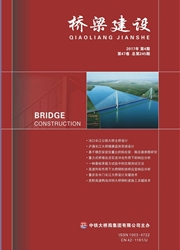

 中文摘要:
中文摘要:
广州市轨道交通二十一号线某高架桥为四跨一联简支转连续刚构桥[跨径(38+40+40+38)m],主梁采用短线法预制节段箱梁,采用架桥机先逐跨拼装成简支梁段,再各跨合龙形成连续刚构体系。针对实际施工中可能出现的3种合龙方案:简支转中墩П型连续刚构,再转全桥刚构的2次体系转换施工(方案1);简支转T构,再转П型连续刚构,最后转全桥刚构的3次体系转换施工(方案2);简支梁转全桥刚构的1次体系转换施工(方案3),采用MIDAS Civil软件建立全桥有限元模型,分析3种方案的结构内力及变形,并从适用性、施工周期等方面进行综合比选,该桥选择方案2施工。采用方案2施工成桥后,墩身位移及主梁挠度均控制较好,全桥结构满足城市轨道交通的运营设计要求。
 英文摘要:
英文摘要:
A viaduct on the Rail Transit Line Twenty-One in Guangzhou City is the continuous rigid-frame bridge with its four spans of (38+40-940+38) m arranged in one continuous unit and with its structural system transformed from the simply-supported beam bridge. The main beam of the bridge is the segmental box beam that was precast by the short line match method, the seg- ments of the beam were firstly assembled into the simply-supported beam segments span by span by the overhead gantry and then the beam segments of the different spans were closed to finally form a continuous rigid-frame system. Considering that the 3 closure schemes might be involved in the actual construction of the bridge, such as the scheme of the 2-time system transformation of firstly transforming the simply-supported beam segments to the H-shape continuous rigid frames on the intermediate piers and then transforming the rigid frames of the whole bridge (scheme 1); the scheme of the 3-time system transformation of firstly transforming the simply-supported beam segments to the T-shape frames, then transforming the T-shape frames to the 1-I-shape continuous rigid frames and finally transforming the rigid frames of the whole bridge (scheme 2) and the scheme of t to the rigid the finite el he 1-time system transformation of transforming the simply-supported beam segments frame of the whole bridge (scheme 3), the software MIDAS Civil was used to set up ement model for the whole bridge, the structural internal forces and deformation of the 3 schemes were analyzed, the applicability and construction periods of the schemes were compre- hensively compared and the scheme 2 was selected for the bridge. With the selected scheme 2, the displacement of the piers and the deflection of the main beam of the completed bridge controlled and the structure of the whole bridge could fulfill the operation and design of the rail transit line in the city. were all well requirements
 同期刊论文项目
同期刊论文项目
 同项目期刊论文
同项目期刊论文
 期刊信息
期刊信息
